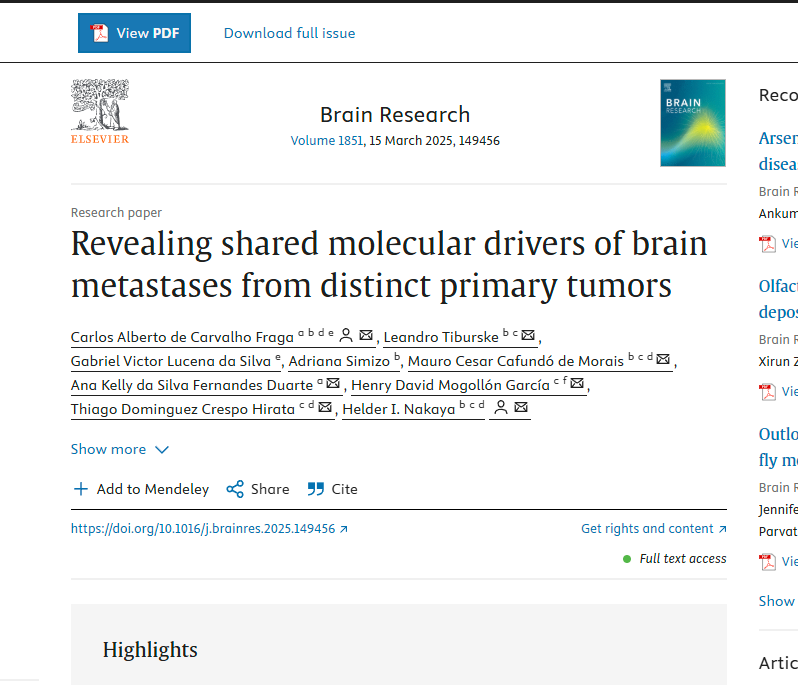Revealing shared molecular drivers of brain metastases from distinct primary tumors.
Brain metastasis is the most common type of brain cancer, associated with significant neurological dysfunction and a poor prognosis. We investigated the transcriptome of 128,421 single-cells of 36 brain metastases, originating from a variety of primary tumors, including melanoma, breast, lung, ovarian, colorectal, and renal cancers. Our aim was to identify common molecular factors across these tumors, shedding light on key interactions that facilitate tumor establishment in the brain. We specifically focused on the dynamics of the blood-tumor barrier and its effects on endothelial cells, pericytes, and astrocytes. Our analysis decoded complex cell-cell communications, emphasizing the crucial role of astrocytes in the tumor microenvironment (TME). This provided insights into how these interactions impact the permeability of the blood-tumor barrier and contribute to the development of brain metastases. We identified the VEGFA, SEMA3, and SPP1 pathways as key regulators in brain metastasis, affecting vascular permeability and cellular dynamics. Spatial transcriptome analysis confirmed our findings and linked these pathways to TME enrichment. The pronounced expression of VEGFA by cancer cells suggests a significant activation of angiogenic pathways, influencing vascular responses and the intricate architecture of brain tissue. The interplay of these signaling pathways underlines the complexity of molecular interactions that define the microenvironment of brain metastases.
Authors
de Carvalho Fraga CA, Tiburske L, Lucena da Silva GV, Simizo A, et al.
External link
Publication Year
Publication Journal
Associeted Project
Network & Precision Medicine
Lista de serviços
-
Gene regulatory and signaling networks exhibit distinct topological distributions of motifs.Gene regulatory and signaling networks exhibit distinct topological distributions of motifs.
-
Gene signatures of autopsy lungs from obese patients with COVID-19.Gene signatures of autopsy lungs from obese patients with COVID-19.
-
Network Medicine: Methods and ApplicationsNetwork Medicine: Methods and Applications
-
ACE2 Expression Is Increased in the Lungs of Patients With Comorbidities Associated With Severe COVID-19.ACE2 Expression Is Increased in the Lungs of Patients With Comorbidities Associated With Severe COVID-19.
-
Drug repositioning for psychiatric and neurological disorders through a network medicine approach.Drug repositioning for psychiatric and neurological disorders through a network medicine approach.
-
Linking proteomic alterations in schizophrenia hippocampus to NMDAr hypofunction in human neurons and oligodendrocytes.Linking proteomic alterations in schizophrenia hippocampus to NMDAr hypofunction in human neurons and oligodendrocytes.
-
In-depth analysis of laboratory parameters reveals the interplay between sex, age, and systemic inflammation in individuals with COVID-19.In-depth analysis of laboratory parameters reveals the interplay between sex, age, and systemic inflammation in individuals with COVID-19.
-
The evolution of knowledge on genes associated with human diseasesThe evolution of knowledge on genes associated with human diseases
-
Network vaccinology.Network vaccinology.
-
Pyruvate kinase M2 mediates IL-17 signaling in keratinocytes driving psoriatic skin inflammationPyruvate kinase M2 mediates IL-17 signaling in keratinocytes driving psoriatic skin inflammation
-
Transcriptome analysis of six tissues obtained post-mortem from sepsis patientsTranscriptome analysis of six tissues obtained post-mortem from sepsis patients
-
Gene Signatures of Symptomatic and Asymptomatic Clinical-Immunological Profiles of Human Infection by Leishmania (L.) chagasi in Amazonian BrazilGene Signatures of Symptomatic and Asymptomatic Clinical-Immunological Profiles of Human Infection by Leishmania (L.) chagasi in Amazonian Brazil
-
In vitro morphological profiling of T cells predicts clinical response to natalizumab therapy in patients with multiple sclerosis.In vitro morphological profiling of T cells predicts clinical response to natalizumab therapy in patients with multiple sclerosis.
-
Integrative immunology identified interferome signatures in uveitis and systemic disease-associated uveitis.Integrative immunology identified interferome signatures in uveitis and systemic disease-associated uveitis.
-
Gene regulatory networks analysis for the discovery of prognostic genes in gliomas.Gene regulatory networks analysis for the discovery of prognostic genes in gliomas.
-
Revealing shared molecular drivers of brain metastases from distinct primary tumors.Revealing shared molecular drivers of brain metastases from distinct primary tumors.

